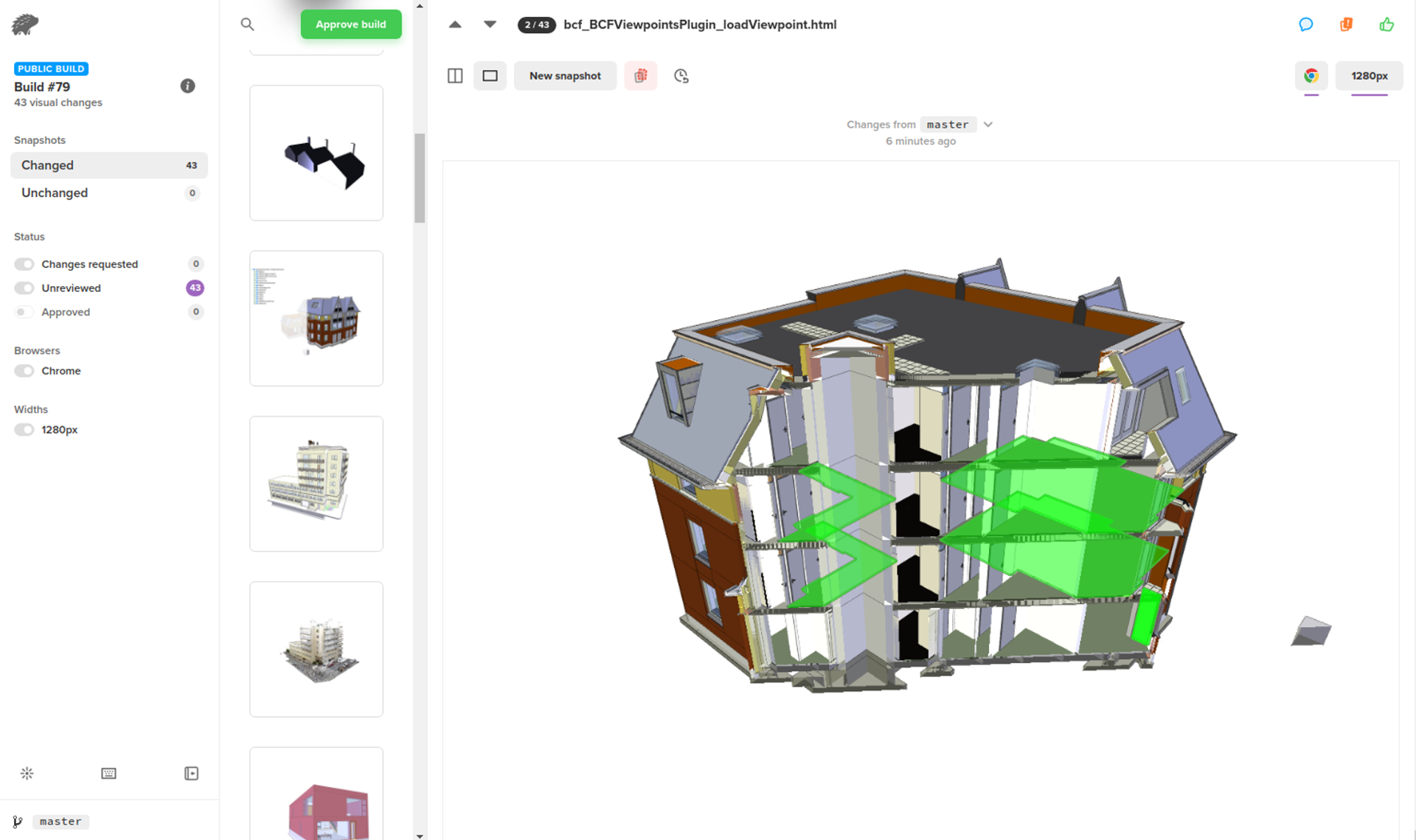xeokit's Automated Visual Test Suite
Introduction
With xeokit supported in most major browsers, it's impossible to maintain that support through manual testing. In this guide, we offer a quick look at how we use continuous integration and automated visual testing to ensure that xeokit continues to work as expected. This is just the bare beginnings of our test suite, which will become more sophisticated as we continue to build it up.
Percy
We use Percy for automated visual testing. Percy's visual test review workflow gives us confidence in xeokit, while at the same time reduces the time taken to review GitHub pull requests.
Each time somebody makes a pull request to one of our repositories, Percy will automatically run our suite of tests on their changes. Percy will then attach the test report to the request, and if any of the tests fail, Percy flags the PR as needing fixes before it can be merged.
Each of our tests is a single HTML page that contains a xeokit Viewer with a full-page canvas. The Viewer in each page is programmed to test a particular feature within xeokit and render the result to its canvas.
When running our tests, Percy will successively load each page into a headless browser, while saving a snapshot of each page to the test report. When snapshot images have changed since the last test run, Percy flags those changes for review.

Percy enables us to integrate visual reviews into our daily workflows, to automate previously manual work. Visual testing is an essential part of maintaining the xeokit repositories with confidence.

We also use Percy to thoroughly test xeokit's native XKT model format and conversion tools.
Percy Setup for xeokit-sdk Repository
Let's take a look at how we've set up visual testing for the xeokit-sdk repository. The file tree below shows the general structure of this repository. We've added three things to support automated visual testing:
-
./testscontains our visual test pages. -
snapshots.jsis the Percy script that runs our test pages. -
./assetscontains our test models and metadata, shared between theexamplesandtestsdirectories.
We've also installed percy/script and http-server as npm dev dependencies in package.json.
xeokit-sdk
│
├── LICENSE.txt
├── README.md
├── CHANGE_LOG.md
├── src
├── docs
├── package.json
│
├── assets
│ ├── models
│ └── metaModels
│
├── examples
│ ├── annotations_clickFlyToPosition.html
│ ├── annotations_clickShowLabels.html
│ ├── annotations_createAtCenterOfClickedObject.html
│ ├── annotations_createWithMouse.html
│ └── ... (more)
│
├── snapshots.js
└── tests
├── loading_XKT.html
├── effects_logarithmicDepthBuffer_PerformanceModel_batching_RTC.html
├── effects_logarithmicDepthBuffer_PerformanceModel_instancing_RTC.html
├── effects_logarithmicDepthBuffer_sceneGraph_RTC.html
└── ... (more)
A Percy test Page
The snippet below shows one of our test pages within the xeokit-sdk repository. This page is called loading_XKT.html and lives in the ./tests directory at the root of the repository.
Our example test page sets up a xeokit viewer, loads a BIM model into it, then calls signalTestComplete to notify the Percy test runner that it's ready to have its snapshot taken. That function is a little helper we created, that inserts a dummy element into the DOM, which the test runner detects.
<!doctype html>
<html lang="en">
<head>
<meta charset="utf-8">
<title>xeokit-sdk Visual Test</title>
<link href="./css/pageStyle.css" type="text/css" rel="stylesheet"/>
</head>
<body>
<canvas id="myCanvas"></canvas>
</body>
<script type="module">
import {Viewer} from "../src/viewer/Viewer.js";
import {XKTLoaderPlugin} from
"../src/plugins/XKTLoaderPlugin/XKTLoaderPlugin.js";
import {signalTestComplete} from "./lib/utils.js";
const viewer = new Viewer({
canvasId: "myCanvas",
transparent: true
});
viewer.camera.eye = [-3.933, 2.855, 27.018];
viewer.camera.look = [4.400, 3.724, 8.899];
viewer.camera.up = [-0.018, 0.999, 0.039];
const xktLoader = new XKTLoaderPlugin(viewer);
const model = xktLoader.load({
id: "myModel",
src: "./../assets/models/xkt/duplex/duplex.xkt",
metaModelSrc: "./../assets/metaModels/duplex/metaModel.json",
edges: true
});
model.on("loaded", () => {
signalTestComplete();
});
</script>
</html>
Percy Test Runner Script
Shown below is the repository's test runner script ./snapshot.js, which lives at the root of the repository. Percy will execute this script to run our tests.
Those testPage calls will process our test pages. Notice our example test page in that sequence, which we've truncated here for brevity. As the script processes each page, it loads the page into Percy's headless browser, then saves a snapshot of the page to the test report.
const PercyScript = require('@percy/script');
const httpServer = require('http-server');
PercyScript.run(async (page, percySnapshot) => {
async function testPage(pageName) {
await page.goto('http://localhost:8080/tests/' + pageName);
await page.waitFor(() => !!document.querySelector('#percyLoaded'));
await percySnapshot(pageName, {
widths: [1280]
});
}
let server = httpServer.createServer();
server.listen(8080);
console.log(`Server started`);
// ...more tests
await testPage('loading_XKT.html');
await testPage('loading_XKT_pointCloud.html');
await testPage('loading_XKT_doublePrecision.html');
await testPage('loading_XKT_dataSource.html');
// ...more tests
server.close();
});
Running the Tests Manually
With the xeokit-sdk repository integrated with percy.io, and having installed percy/script and http-server as npm dev dependencies, we can run its visual test suite from the console. Only project admins can do that though, since they'll need the authorization token from percy.io.
export PERCY_TOKEN=<our percy token>
npm run test
> percy exec -- node ./snapshots.js
[percy] created build #78: https://percy.io/73524691/xeokit-sdk/builds/9797656
[percy] percy has started.
Server started
[percy] snapshot taken: 'sceneRepresentation_PerformanceModel_batching_triangles.html'
[percy] snapshot taken: 'sceneRepresentation_PerformanceModel_batching_geometries.html'
[percy] snapshot taken: 'sceneRepresentation_PerformanceModel_batching_RTC_triangles.html'
//...
[percy] stopping percy...
[percy] waiting for 43 snapshots to complete...
[percy] done.
[percy] finalized build #79: https://percy.io/73524691/xeokit-sdk/builds/9797715
